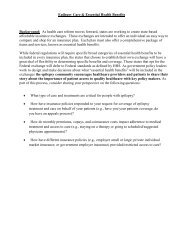Legal Rights of Children with Epilepsy in School & Child Care
Legal Rights of Children with Epilepsy in School & Child Care
Legal Rights of Children with Epilepsy in School & Child Care
Create successful ePaper yourself
Turn your PDF publications into a flip-book with our unique Google optimized e-Paper software.
CHAPTER SIX<br />
Special Education and Students <strong>with</strong> <strong>Epilepsy</strong>: Specific Issues<br />
6.1Q:<br />
May school staff require that a student <strong>with</strong> epilepsy wear a helmet to keep<br />
him or her safe <strong>in</strong> case <strong>of</strong> a seizure?<br />
A: No. <strong>School</strong> staff may not simply force a student <strong>with</strong> epilepsy to wear a helmet<br />
for safety reasons <strong>with</strong>out go<strong>in</strong>g through the IEP process. If school staff believe<br />
a helmet is necessary, the IEP team can discuss the issue and propose to add the<br />
helmet to the student’s IEP. There should be medical justification for the helmet,<br />
based on an <strong>in</strong>dividualized evaluation <strong>of</strong> the student. If the student’s parents<br />
disagree <strong>with</strong> the use <strong>of</strong> the helmet, they can appeal. It is important to note that<br />
use <strong>of</strong> a helmet does not have to be an all-or-noth<strong>in</strong>g endeavor, however. It may<br />
be that narrow and judicious use <strong>of</strong> a helmet <strong>in</strong> certa<strong>in</strong> circumstances, such as<br />
outdoors for a student <strong>with</strong> unpredictable drop seizures, is appropriate, but<br />
<strong>in</strong>doors, use <strong>of</strong> the helmet is not necessary. If a helmet is used, the specific<br />
circumstances when it may be used should be clearly specified on the student’s<br />
IEP. The helmet should be used only when necessary so that the student is able<br />
to participate <strong>in</strong> educational activities safely. 43<br />
6.2Q:<br />
May school staff require that a student <strong>with</strong> epilepsy be strapped <strong>in</strong>to his or<br />
her classroom chair for safety or any other reasons?<br />
A: No. Strapp<strong>in</strong>g a student <strong>in</strong>to a chair is a restra<strong>in</strong>t, and parents should be wary <strong>of</strong><br />
a request by school staff for permission to do so, even if it is couched <strong>in</strong><br />
language about the student’s safety. The regulations implement<strong>in</strong>g the IDEA at<br />
34 C.F.R. 300.320(a)(4) require IEPs to <strong>in</strong>clude a statement <strong>of</strong> the special<br />
education and related services, <strong>in</strong>clud<strong>in</strong>g supplementary aids and services “based<br />
on peer-reviewed research to the extent practicable,” that will be provided to a<br />
student. Parents can ask for the peer-reviewed research that supports strapp<strong>in</strong>g a<br />
child <strong>with</strong> epilepsy <strong>in</strong>to a chair for safety or other reasons; it is unlikely that<br />
school staff will be able to produce any research to support their position.<br />
Additionally, parents can seek to ensure that equipment such as special<br />
position<strong>in</strong>g chairs or other devices that may be used <strong>with</strong> their children be used<br />
only for the purpose <strong>in</strong>tended by the manufacturer, and that use <strong>of</strong> such<br />
equipment and the purpose for which it will be used be specified <strong>in</strong> the IEP. If a<br />
parent is will<strong>in</strong>g to agree to a restra<strong>in</strong>t or to the use <strong>of</strong> a safety device, it should<br />
be <strong>in</strong>cluded on the student’s IEP.<br />
43 See, e.g., South Vermillion Community <strong>School</strong> Corporation, Indiana State Educational Agency, 1262.01<br />
(October 2, 2002), 37 IDELR 270 (uphold<strong>in</strong>g helmet for child <strong>with</strong> epilepsy because it was part <strong>of</strong> an<br />
agreed upon IEP, even though parents sought to challenge its use.)<br />
84








